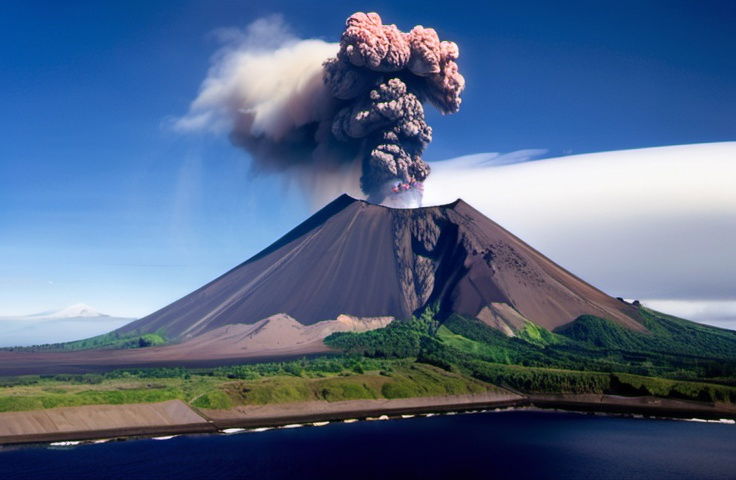
Posted on 01/30/2025 9:22:00 AM PST by Red Badger

Scientists studying six North American volcanoes situated along the continent’s Cascade Range have found active magma underneath both active and dormant volcanic sites.
Previous research has suggested that volcanoes lose significant magma volume when they erupt, and any remaining magma dissipates over time.
The scientists behind the discovery argue that a better understanding of the conditions underneath volcanoes could answer several enduring questions about their lifecycles, including whether or not all dormant volcanoes contain pools of magma underneath. The researchers also believe a better understanding of these magma-filled chambers could help inform efforts to prepare for potential volcanic eruptions.
Even North American Volcanoes Dormant for Millenia Had Magma Underneath
Although there are volcanoes on every continent, including Antarctica, the Cornell University researchers behind this latest study focused on a series of six volcanoes of varying size and dormancy situated along the Cascade Range. That massive mountain range, which extends from southern British Columbia through Washington and Oregon before terminating in Northern California, includes half of the volcanoes designated as “very high threat” by the U.S Geological Survey.
Because the chambers beneath volcanoes are difficult to access, the Cornell team used seismic waves to create sonic “images” of the volcanic chamber’s size, shape, and dimensions. To their surprise, the researchers found magma beneath all of the volcanoes they studied. This was particularly unexpected in volcanoes like the picturesque Crater Lake, which have been geologically dormant for thousands of years.

A picture of Crater Lake, a dormant volcano, during winter. Image credit: National Park Service.
“Regardless of eruption frequency, we see large magma bodies beneath many volcanoes,” said Guanning Pang, a postdoctoral researcher and the study’s lead author, in a statement. “It appears that these magma bodies exist beneath volcanoes over their whole lifetime, not just during an active state.”
Although the researchers are unsure of the exact dynamics behind the magma chambers, they suspect that a volcanic eruption lets off some of this excess magma and pressure but does not completely drain the chamber. After the eruption, they believe the chamber slowly expands and refills gradually over time due to a gradual melting of the crust.
Understanding Magma Dynamics Could Assist Monitoring for Volcanic Eruptions While the team’s findings are limited to a handful of North American volcanoes, the researchers suspect that most, if not all, of the world’s volcanoes, regardless of dormancy, may have a massive amount of magma underneath them. Pang says this would be particularly significant since researchers used to think that finding magma underneath a volcano meant it might be preparing to erupt.
“We used to think that if we found a large amount of magma, that meant increased likelihood of eruption,” the researcher explained, “but now we are shifting perception that this is the baseline situation.”
In the study’s conclusion, the researchers note that the U.S. Geological Survey has been actively “expanding and upgrading” their network of monitors designed to track volcanic activity within the Cascade Range. They say those same efforts are also expanding to other North American volcanoes, including several volcanoes in Alaska, as part of the National Volcano Early Warning System, “with the aim of detecting signals of an impending eruption as early as possible.”
“If we had a better general understanding of where magma was, we could do a much better job of targeting and optimizing monitoring,” said Geoffrey Abers, professor in geological sciences at Cornell. Such work is critical, Abers said, as the world contains a “great many volcanoes that are sparsely monitored or have not been subject to intensive study.”
The study “Long-lived partial melt beneath Cascade Range volcanoes” was published in Nature Geoscience.
Making America Geologically Magical Again. Up with magma! Down with subduction zones!
It works for me, too.
I, for one, welcome our new Fire Elemental overlords.
:D
 If you would like more information about what’s happening in Oregon, please FReepmail me. Please send me your name by FReepmail if you want to be on this list.
If you would like more information about what’s happening in Oregon, please FReepmail me. Please send me your name by FReepmail if you want to be on this list.
Here in Washington state, we have several....
Baker
Glacier Peak
Rainier
Adams
and the one everyone’s heard of, St. Helens
If any of them blew, it’d be a disaster. The one past scientists are most afraid of is Rainier, the biggest one. Tons of people live in its shadow and along the rivers that come off of it.
Ah, Hawaii.....Memories, used to live on the Big Island. Went up many times to the Volcano park to hike.
I’ve been to Crater Lake. It is SO gorgeous. Everyone should see it! Really stunning. Would be a shame for her to blow. :(
Trump is certainly cracking heads like Godzilla! MAGA! :)
MAGMA!
Make America Great Muchly Again! :)
LOL
I disagree. Significant magma under long dormant volcanos is a very interesting finding. Either they are not as "dormant" as we thought, or they die very, very slowly.
I have no idea how much grant money was spent on this, but this is how science works. Build one brick at a time and eventually we get an entire new building.
I would suspect that any volcano with seismic activity has an active magma chamber.
Seattle and Portland hardest hit
Disclaimer: Opinions posted on Free Republic are those of the individual posters and do not necessarily represent the opinion of Free Republic or its management. All materials posted herein are protected by copyright law and the exemption for fair use of copyrighted works.